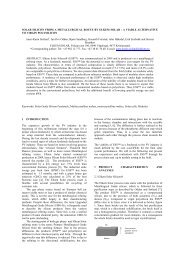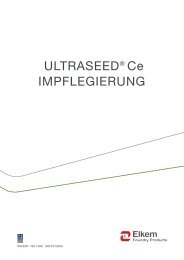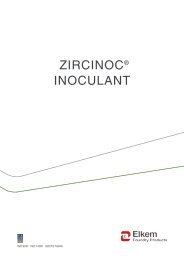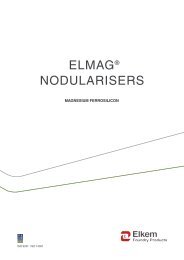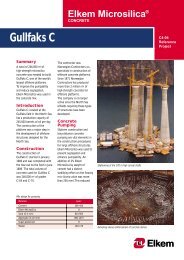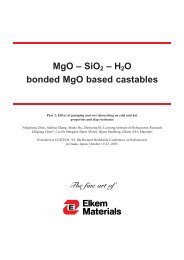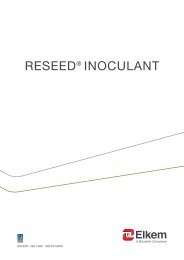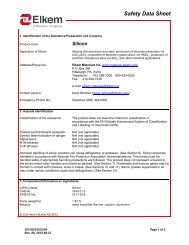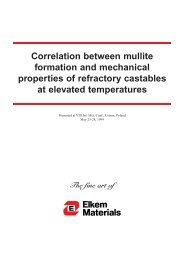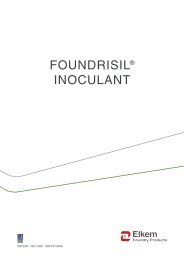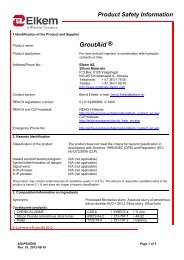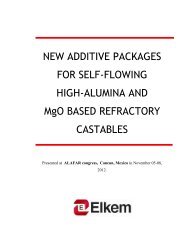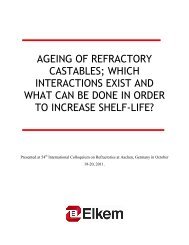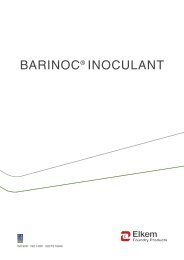You also want an ePaper? Increase the reach of your titles
YUMPU automatically turns print PDFs into web optimized ePapers that Google loves.
Let´s <strong>Make</strong><br />
a <strong>Mullite</strong> <strong>Matrix</strong>!<br />
Published in Refractories Applications and News, in press.<br />
The fine art of
Introduction:<br />
Let’s make a mullite matrix!<br />
Bjørn Myhre, <strong>Elkem</strong> Materials<br />
P.O. Box 8126 Vaagsbygd, 4675 Kristiansand, Norway<br />
In the paper “Let’s make a castable!” 1 , we went through proportioning of refractory castables,<br />
and the beneficial effect microsilica addition has on casting properties.<br />
It is however, not only flow and packing that are influenced by microsilica additions, also<br />
high-temperature properties like hot-strength are affected. In the following paper, arguments<br />
are put forward why microsilica additions at relatively high levels bring out the best of the<br />
alumina-silicate castable. Implicitly this also shows why substitution of microsilica by<br />
reactive alumina may not be such a good idea after all.<br />
To begin with, let us look at the picture below:<br />
These crystals are mullite crystals that are found on the fractured surface of an ultralow<br />
cement refractory castable based on white fused alumina and microsilica, with only 0.5wt%<br />
cement after hot-MOR testing at 1500°C. If the microsilica content is too low or the cement<br />
content too high, these mullite crystals will not form. Quite opposite, instead of this strong<br />
and robust bond, a liquid forms which causes catastrophic lowering of hot-strength. What<br />
happens and why?<br />
Alumina-silicate refractories:<br />
It is commonly accepted that a mullite bond-phase is beneficial for high temperature<br />
properties such as hot-strength and thermal-shock resistance. In bricks, the bond is normally<br />
in place when the refractory is installed. In castables on the other hand, the mineralogical<br />
make-up of the bond-phase goes through several intermediates during heat-up and hopefully<br />
ends up with the desired physical and mineralogical properties at service temperatures. If the<br />
composition of the bond phase is incorrect, the result may on the other hand be disappointing,<br />
1 More about the proportioning and making of castables can be found in the paper “Lets make a castable”,<br />
downloadable from www.refractories.elkem.com, also published in<br />
“Refractories Applications and News” vol 13 (3)May/June 2008 p. 16-25. www.ranews.info<br />
<strong>Elkem</strong> Materials – page 1
leading to softening and refractory failure at a much lower temperature than anticipated. If<br />
one succeeds in creating a bond system with mullite formation though, the softening may be<br />
postponed by several hundred degrees, which generally should provide improved service life.<br />
Relevant assumptions:<br />
In the following paper, it is assumed that the scenario is a refractory castable based on<br />
alumina-silicate aggregates with fine alumina and microsilica in the matrix together with<br />
cement. The variables are microsilica and cement, and it is assumed that there is always<br />
enough alumina available for the mullitization reaction. Typical sources for such alumina are:<br />
calcined alumina, reactive alumina, milled fused alumina (e.g.
Figure 2: Hot modulus of rupture as a<br />
function of time at 1400 and 1500°C for a<br />
fused alumina based castable with 0.5wt%<br />
hydraulic alumina in combination with<br />
0.5wt% cement. 8wt% microsilica.<br />
At 1400°C, the strengthening (which is caused by the mullite formation) continues for<br />
perhaps more than a day, while at 1500°C the reaction is completed within a few hours at<br />
temperature. At 1300°C, unpublished data have indicated that the strengthening by the<br />
mullitization occurs at a very low speed.<br />
Once the mullite bond is established, it is permanent. This means that if e.g. a castable like<br />
that in Figure 2 is prefired for 5 hours at 1500°C and then tested at 1400°C, then the hot-<br />
M.O.R. will be higher than for a sample which has been held at 1400°C for 5 hours. Around<br />
25-30MPa would probably be obtained in such a test.<br />
This example was for a castable with only minute amounts of cement (i.e. CaO) so that we<br />
may correlate the strengthening with the predictions from the phase diagram, Figure 1, where<br />
a liquid forms and mullite crystallizes from this liquid.<br />
Castables normally contain several percent of cement to give green-strength. A certain<br />
amount of calcia is thus introduced. Since this lime is localized in the bond phase, which<br />
normally makes up around one third of a castable, the lime concentration becomes quite<br />
significant and has to be accounted for.<br />
The ternary phase diagram Al2O3 – SiO2 – CaO incorporates the cement:<br />
It is generally accepted that cement in combination with microsilica and alumina gives lower<br />
hot-strength with increased cement content. If you ask why this is so, the explanation is<br />
normally some vague reference to “low melting liquids in the system”, which is an<br />
explanation that may be good enough for some people, but has never satisfied me. During<br />
many years of research in refractory castables, the following conviction has gradually<br />
manifested:<br />
Basis for all the explanations should be the phase diagram. Particularly for castables based on<br />
relatively pure ingredients of silica, alumina and lime, it should be able to explain many<br />
observations by interpretation of the phase diagram Al2O3 – SiO2 – CaO. One should however<br />
always remember that the phase diagram supposes equilibrium, - which is normally not the<br />
case in your castable.<br />
<strong>Elkem</strong> Materials – page 3
Figure 3: The phase diagram Al2O3-SiO2-CaO after Osborn and Muan. 4<br />
Figure 3 shows the ternary phase diagram Al2O3-SiO2-CaO with additions relevant to the<br />
present topic.<br />
The gross composition:<br />
First of all, when dealing with a mullite bond, the mullite must be stable. This means that the<br />
composition of the castable and bond phase must be in one of the two compatibility triangles<br />
indicated in Figure 3, either i) corundum, anorthite and mullite; or ii) mullite, anorthite and<br />
silica. If the composition is outside, then mullite will not be stable, and if it forms at all, it will<br />
dissolve over time. Most alumina castables are fortunately in the corundum corner of the<br />
phase diagram. The hatched area in the corner indicates possible compositions (corundum<br />
castables) and relevant silica and cement contents are indicated.<br />
Cement and microsilica reactions:<br />
One may assume that the cement and the microsilica react during heating 6 . If the cement<br />
composition is indicated on the calcia-corundum join (here a 71%CA cement) and a line is<br />
drawn towards the silica corner, one may by the use of the lever rule determine the minimum<br />
silica/cement ratio that is needed to enter the stability regions of mullite. Here as indicated,<br />
the minimum amount of microsilica as compared to cement is around 35wt% microsilica and<br />
4 A. Muan and E.F. Osborn :"Phase Equilibria Among Oxides in Steelmaking" Addison-Wesley Publ.<br />
Comp., Inc., 1965<br />
peritectic<br />
<strong>Elkem</strong> Materials – page 4
65wt% cement. Or said in other words; a castable with less than 3.5wt% microsilica at<br />
6.5wt% cement will start to dissolve mullite when it is heated.<br />
One important corollary that may be found in the phase diagram is connected to the peritectic<br />
at 1512°C, located close to the composition of Anorthite. Basic knowledge of phase diagrams<br />
and crystallization paths tells us that if we have a liquid with a composition within the<br />
compatibility triangle Corundum-Anorthite-<strong>Mullite</strong> (e.g. a molten castable) and cool it, then:<br />
1) Corundum precipitates and the composition of the remaining liquid moves away from<br />
corundum, until 2) mullite starts precipitating and, 3) the last liquid disappears at 1512°C at<br />
the peritectic composition.<br />
For the formation of mullite in a castable, the following reaction pattern has been suggested 6 :<br />
Initially all microsilica and cement, possibly with some alumina, create a liquid<br />
supersaturated in silica at temperatures from approximately 1300°C. The supersaturated liquid<br />
crystallizes mullite until a stable composition is attained. This stable liquid has the peritectic<br />
composition. One may add to this that upon heating, to 1512°C, the mullite is stable in this<br />
environment, after which the mullite starts to dissolve in an opposite pattern as the<br />
crystallization described above.<br />
Such a peritectic liquid has been detected both directly 5,6 and indirectly 7 in castables with<br />
mullite formation.<br />
The existence of a liquid from which mullite forms is not only found in cement containing<br />
systems, it is also a consequence of the meta-stable binary system shown in Figure 1. The<br />
mullite formation is seen in Figure 2 as the strengthening of the castable with time.<br />
Practical consequences:<br />
Since the phase diagram indicates that we should expect a stable (more or less) liquid that<br />
contains calcia, silica and alumina (15wt%CaO, 48wt%SiO2, 37wt%Al2O3), and that the<br />
microsilica and cement react to form the origin of this liquid, we cannot expect that mullite<br />
will be expelled unless there is an excess of microsilica. I.e. in a LCC with 6wt% CA cement<br />
(70wt%A, 30wt%C), more than 5.7wt% microsilica is bound up in the peritectic liquid. If<br />
6wt% microsilica was used in the castable, less than 1wt% mullite should be expected in the<br />
final refractory, and total softening should commence below 1500°C on heating. More<br />
microsilica gives proportionally more mullite and better strength should be expected.<br />
It should be emphasized that it is not only the stability of mullite that matters. Since the<br />
mullite is expelled from a liquid, the amount of residual liquid is important. To strengthen the<br />
castable, each mullite crystal must connect two or more aggregate grains. With more residual<br />
liquid more mullite is needed, and the stronger is the influence of increased temperature. A<br />
powerful tool to overcome some of these problems is to reduce the level of cement, as will be<br />
seen in the following section.<br />
5 U. Schuhmacher: Untersuchungen an zementarmen und ultrazementarmen Korundfeuerbetonen. Dr. Ing.<br />
thesis, Rheinish-Westfälishen Technishen Hochschule Aachen, Germany 1988.<br />
6 B. Myhre, "Hot Strength and Bond-Phase Reactions in Low and Ultralow-cement castables" in<br />
Proceedings of UNITECR´93, Oct. 31 - Nov. 3 1993 Sao Paulo, Brazil p. 583-94<br />
7 B. Myhre, A.M. Hundere, H. Feldborg, C. Ødegård:” Correlation between mullite formation and<br />
mechanical properties of refractory castables at elevated temperatures” Presented at VIII Int. Met. Conf.<br />
Ustron, Poland. May 25-28, 1999<br />
<strong>Elkem</strong> Materials – page 5
Examples:<br />
In this part of the paper, some examples of the mullitization in castables will be shown. One<br />
system based on white fused alumina, which serves as a model system, and one based on<br />
Chinese bauxite aggregates.<br />
Methodology:<br />
Hot- Modulus Of Rupture (H-M.O.R.)<br />
This picture shows the testing of the hot<br />
Modulus of Rupture of a castable sample<br />
(25x25x150mm) at a relatively low<br />
temperature, around 700-800°C. Hot<br />
M.O.R. testing gives relevant data on<br />
strength of castable at temperature, but in<br />
Refractoriness Under Load (R.U.L):<br />
many cases where standards dictate a tooshort<br />
soak, the “equilibrium” values are<br />
never obtained. This applies in particular<br />
for some of the mullite forming reactions<br />
we deal with here, and we therefore advise<br />
a 24 hour soak prior to testing in order to<br />
advance some of the slower reactions.<br />
Common standards on hot-M.O.R. testing<br />
normally open for a wide variation in<br />
heating schedules and soak times, and<br />
these should always be indicated in reports<br />
and figures covering the issue. In <strong>Elkem</strong>’s<br />
laboratories, heating rate is normally<br />
300K/h (5K/min) up to temperature with a<br />
subsequent soak of some 30 min to<br />
equilibrate, or a longer soak depending on<br />
scope and thermal history.<br />
Refractoriness under load is another thermo mechanical technique that is useful in the<br />
investigation of refractory castables. Briefly, the test consists of a furnace equipped with a<br />
sample holder that allows the measurement of the sample height as a function of temperature<br />
at a given load.<br />
The temperature is normally increasing by 300K/h, as in the Hot-M.O.R. testing. In the <strong>Elkem</strong><br />
laboratories a load of 0.2MPa is normally applied, although some standards advise lower<br />
loads for unshaped refractory products. The sample is in the shape of a cylinder with a central<br />
bore in which a thermocouple and a measuring rod are placed which transmit the distance<br />
between the top and bottom. The readings must be corrected for the thermal expansion of the<br />
measuring rods in order to get correct numbers.<br />
<strong>Elkem</strong> Materials – page 6
In this picture, the experimental set-up is<br />
shown. The sample is the cylinder placed<br />
Castables based on white fused alumina:<br />
between the two lightly yellow alumina<br />
discs on top of the set up. Above the<br />
sample is the furnace, which is lowered<br />
onto the sample and the load is regulated<br />
by a set-up with counter weights. It is seen<br />
that this sample has been tested to a<br />
temperature with significant subsidence,<br />
due to the slight drum shape the cylinder<br />
attains during testing with deformation.<br />
As is the case with hot-M.O.R.<br />
measurements, the results can be vastly<br />
different depending on thermal history, and<br />
unless pre-firing conditions are given, the<br />
interpretation of the test may in some cases<br />
be very difficult or close to meaningless.<br />
In the following section, the effect of microsilica and cement content on mullite formation<br />
will be presented for our model system based on white fused alumina. All aggregates are a<br />
high grade, white fused alumina. Together with calcined/reactive alumina, cement and<br />
microsilica, the castables were composed to have the same particle size distribution and water<br />
addition. To keep the particle size distribution as constant as possible, microsilica and reactive<br />
alumina with similar PSD were substituted for each other. More results, incl. recipes can be<br />
found in earlier papers 6, 8, 9 downloadable through www.refractories.elkem.com.<br />
The compositions are given in the Appendix, Tables 1 and 2, and are based on data from Ref.<br />
[8]. Some of the results (Figures 4, 7 and 8) are taken from earlier investigations (1997-99)<br />
and some (Figures 5, 6, 9, and 10) are recent (2007) remakes of these mixes. As some of the<br />
original ingredients are no longer available, these have been replaced by recent replacement<br />
materials. As the chemistry and PSD is very similar, it is considered justified to compare the<br />
new results (obtained in 2007) with the old data (from 1997-99).<br />
8 B. Myhre and Aase M. Hundere: “Substitution of Reactive Alumina with Microsilica in Low<br />
Cement and Ultra Low Cement Castables. Part I: Properties Related to Installation and Demoulding”<br />
in Proc. UNITECR´97, New Orleans, USA, Nov. 4-7 1997, p. 43-52<br />
9 Aa. M. Hundere and B. Myhre:” Substitution of Reactive Alumina with Microsilica in Low Cement and<br />
Ultra Low Cement Castables, Part II: The Effect of Temperature on Hot Properties.” Proc.<br />
UNITECR’97, New Orleans, USA, Nov. 4-7, 1997 p. 91-100<br />
<strong>Elkem</strong> Materials – page 7
Low cement castables<br />
Hot M.O.R. (MPa)<br />
30<br />
25<br />
20<br />
15<br />
10<br />
5<br />
0<br />
1100 1200 1300 1400 1500 1600<br />
Temperature (C)<br />
8wt% MS<br />
6wt% MS<br />
4wt% MS<br />
2wt% MS<br />
Figure 4: Hot-M.O.R. of low cement (6wt% cement), fused alumina-based castables as a<br />
function of temperature. Castables with different amounts of microsilica. 24 hours<br />
at temperature. q=0.25, max. particle size 4mm, 13 vol% water for casting (3.8-<br />
4.2wt%) From Ref.[7]<br />
In Figure 4, results from a low-cement castable with 6wt% cement are shown for several<br />
different microsilica contents. We see that at 1400°C, strength increases as the microsilica<br />
addition increases. Particularly, levels of 6 and 8wt% microsilica seem beneficial to strength.<br />
It should be noted that mullite was not detected 7 at 1400°C unless 6 or 8% microsilica was<br />
used. With 6wt% microsilica only 1wt% mullite was found, which is in good correlation with<br />
the reactions and consequences described earlier in this paper. The peritectic liquid, being<br />
approximately 11wt% of the castable may, at 1400°C, be either highly viscous or even<br />
partially crystalline, which explains the strengthening effect seen at 1400°C. At 1500°C, the<br />
peritectic composition melts and starts attacking the mullite bond, with more or less total<br />
strength loss as result.<br />
In Figure 5, the effect of pre-firing of a low-cement castable on R.U.L results is seen. In this<br />
case we see that prefiring at high temperatures lowers the onset of “final subsidence”. Based<br />
on the findings of the sample prefired at 1000°C, one could be led to believe that the castable<br />
would tolerate a temperature of 1600°C. This is however difficult to understand if the hot-<br />
M.O.R. results shown in Figure 4 are taken into consideration, and even more if the phase<br />
diagram is consulted. The reason for this decline in refractoriness by the pre-firing, can be<br />
explained in the following manner: The mullite bond establishes so rapidly that the bond<br />
phase does not reach equilibrium. Then as equilibrium slowly commences, the bond phase is<br />
attacked and slowly dissolved by the lime-containing liquid; probably only partly, but at least<br />
sufficiently to allow a rapid subsidence at 1500°C.<br />
<strong>Elkem</strong> Materials – page 8
Expansion [%]<br />
3<br />
2<br />
1<br />
0<br />
-1<br />
-2<br />
-3<br />
-4<br />
0 200 400 600 800 1000 1200 1400 1600 1800<br />
Temperature [°C]<br />
Prefired 1000°C<br />
Prefired 1500°C<br />
Figure 5: Refractoriness under load for a white fused alumina-based LCC with 6% cement<br />
and 8% microsilica. Samples pre-fired for 24 hours at 1000 or 1500°C.<br />
Expansion [%]<br />
2<br />
1<br />
0<br />
-1<br />
-2<br />
0 200 400 600 800 1000 1200 1400 1600 1800<br />
Temperature [°C]<br />
LCC 4%MS<br />
LCC 8%MS<br />
Figure 6: Refractoriness under load. LCC based on white fused alumina. Samples with 4 and<br />
8% microsilica pre-fired at 1500°C prior to testing.<br />
Figure 6 shows that there is practically no difference in the R.U.L behavior for the LLC with<br />
6% cement if 4 or 8% microsilica is used in the mix and if the castable has been pre-fired to<br />
1500°C. Even if no additional refractoriness (as per R.U.L.) is gained by use of 8%<br />
<strong>Elkem</strong> Materials – page 9
microsilica, due to placing properties and hot strength (Figure 4), it may be a good idea,<br />
though, to use 8% microsilica and not substitute parts of it with reactive alumina.<br />
Reduced cement castables:<br />
We did see in Figure 4 that meltdown (at 1500°C) of massive amounts (11wt%) of peritectic<br />
liquid softened the castable severely. The amount of this liquid may be reduced in two ways,<br />
either by lowering the cement content, or by lowering the silica content. If the latter choice is<br />
sought, according to the phase diagram, no mullite bond will be established, and also by<br />
entering other compatibility triangles (e.g. less than 3.5wt% microsilica for 6.5wt% cement)<br />
other eutectic and peritectic phases take over the role of “our” peritectic. These new phases<br />
have even lower melting points, one as low as 1380°C. The latter is attained with microsilica<br />
contents between 0.6 and 3.2wt%microsilica at 6wt% cement. One may remove microsilica<br />
entirely, but then one excludes the use of alumina-silicate aggregates and fines.<br />
To be frank, taking the refractoriness into consideration, it is a better proposal to reduce the<br />
cement content. This is of course if the castable is intended to be used at temperatures<br />
approaching 1500°C or higher, since at lower temperatures, the cement bond has so many<br />
positive attributes, including a high green-strength, etc.<br />
Figure 7 shows the effect of lowering cement content on hot-M.O.R. These castables all<br />
contain white fused alumina and 8wt% microsilica, and the variable is the cement content. All<br />
castables exhibit mullite formation, which is seen as an increase in hot-M.O.R. from 1300 to<br />
1400°C. Typically there is a minimum at 1300°C, and at this temperature, some plasticity<br />
may also be found. The softening may (at least for the 0.5wt% cement and no-cement<br />
castables) be connected to the metastable liquid formation of the binary system SiO2-Al2O3<br />
(Figure 1). At 1500°C both the 0.5wt% cement and the cement-free compositions exhibit<br />
superior strength as compared to the low cement (6%) castable. The slightly better<br />
performance at 1500°C for the cement-free castables as compared to the 0.5wt% castable,<br />
may be attributed to the tiny amounts (1wt%) of peritectic liquid in the latter, which start<br />
attacking the mullite bond upon further heating. It should again be stressed that the mullite<br />
formation is irreversible at sub-solidus temperatures, (
Hot M.O.R. (MPa)<br />
30<br />
25<br />
20<br />
15<br />
10<br />
5<br />
0<br />
1100 1200 1300 1400 1500 1600<br />
Temperature (C)<br />
6 wt% cement<br />
0.5 wt% cement<br />
No cement<br />
Figure 7: Hot M.O.R. of fused alumina-based castables with 8 wt% microsilica as a<br />
function of temperature. q=0.25, max. particle size 4mm, 13 vol% water for<br />
casting (4.2wt%). From Ref. [7]<br />
Ultralow cement castables:<br />
In ultralow cement castables, the amount of peritectic liquid is significantly reduced, and the<br />
fluxing effect is consequently much lower. The result is a castable that – provided the<br />
aggregates are resistant- will be much more refractory than its low-cement counterpart. This<br />
difference is clearly shown in Figure 7. In Figure 8, the dependence of hot-M.O.R. on<br />
microsilica content is shown as a function of temperature. It is clear that with more<br />
microsilica, more mullite precipitates and stronger castables are made. Theoretically the<br />
peritectic should only account for 0.5% microsilica and mullite should be formed from the<br />
excess. However, such high amounts are normally not detected 7 , which is probably connected<br />
to kinetic hindrances.<br />
The strong dependence of hot-M.O.R. on microsilica content at 1500°C as seen in Figure 8 is<br />
again probably an effect of the melting of the peritectic phase. Although the melting point<br />
theoretically is 1512°C, early investigations 6 revealed that it contains relatively significant<br />
amounts of impurities, notably alkalis, which would lower melting temperature. A melting<br />
around 1500°C is hence likely. Upon heating, this liquid attacks the mullite and it becomes<br />
important to have massive precipitations in order to maintain strength to high temperatures.<br />
<strong>Elkem</strong> Materials – page 11
Hot M.O.R. (MPa)<br />
30<br />
25<br />
20<br />
15<br />
10<br />
5<br />
0<br />
1100 1200 1300 1400 1500 1600<br />
Temperature (C)<br />
8wt% MS<br />
6wt% MS<br />
4wt% MS<br />
2wt% MS<br />
Figure 8: Hot-M.O.R. of ultralow cement (0.5wt% cement), fused alumina-based castables as<br />
a function of temperature. Castables with different amounts of microsilica. 24 hours<br />
at temperature. q=0.25, max. particle size 4mm, 13 vol% water for casting (3.8-<br />
4.2wt%). From Ref.[7]<br />
The irreversible nature of the mullite formation must be remembered, and the fact that the<br />
softening at 1300°C is only a metastable phenomenon related to the mullite formation, as is<br />
envisaged in Figure 9.<br />
Figure 9 shows a comparison of Refractoriness Under Load (5°K/min) for two parallels with<br />
different pre-firing conditions. The sample pre-fired at 1000°C starts to subside at<br />
approximately 1300°C, and then from approximately 1500°C, mullite strengthens the sample<br />
sufficiently to regain strength. Final softening commences around 1700-1750°C.<br />
With mullitization in place before testing , e.g. with pre-firing at 1500°C, the softening does<br />
not appear until the castable starts its final subsidence at temperatures around 1650-1700°C.<br />
All in all, a castable showing remarkably good properties, considering that it contains 8wt%<br />
microsilica, and a big improvement as compared to the low-cement castable shown in Figures<br />
5 and 6.<br />
<strong>Elkem</strong> Materials – page 12
Expansion [%]<br />
2<br />
1.5<br />
1<br />
0.5<br />
0<br />
-0.5<br />
0 200 400 600 800 1000 1200 1400 1600 1800 2000<br />
Temperature[°C]<br />
ULCC 1000°C/24h<br />
ULCC 1500°C/24h<br />
Figure 9: R.U.L. (0.2MPa) of ultralow-cement castable based on white fused alumina with<br />
0.5wt% cement and 8wt% microsilica as a function of pre-firing conditions.<br />
In Figure 8, hot-M.O.R. of ULCC’s with various microsilica contents were shown. Based on<br />
these results, a series of R.U.L. measurements were made and Figure 10 shows the results.<br />
Expansion [%]<br />
1.5<br />
1<br />
0.5<br />
0<br />
-0.5<br />
-1<br />
-1.5<br />
0 200 400 600 800 1000 1200 1400 1600 1800 2000<br />
Temperature [°C]<br />
8%<br />
2% 6%<br />
Figure 10: R.U.L. of ULCC pre-fired 24 hours at 1000°C. Castables where parts of the<br />
m microsilica has been replaced by reactive alumina. Microsilica content indicated<br />
n next to the curves.<br />
4%<br />
0%<br />
<strong>Elkem</strong> Materials – page 13
The characteristics of these castables are that, except for the microsilica/reactive alumina<br />
makeup, everything was sought to be kept constant. Particle size distribution was constant (by<br />
replacement of microsilica by reactive alumina), water addition (in vol%) was constant, raw<br />
materials were constant, etc. What we can see from Figures 8 and 10 is that a minimum<br />
amount of microsilica (4%?) seems to exist, which has to be exceeded in order to get visible<br />
effects of mullite formation. This may not only be caused by the reduction of mullite which<br />
forms by the lowering of the microsilica content, but may also be connected to kinetic<br />
hindrances. Another explanation is that in order to bond adjacent alumina grains a minimum<br />
amount of mullite is required. The next thing that Figure 10 tells us is that it may not be a<br />
good idea to replace microsilica by reactive alumina, - at least not in this kind of castable<br />
based upon white fused alumina. With alumina-silicate raw materials, the picture may not be<br />
that clear-cut, but these things have to be further investigated.<br />
Castables based on bauxite aggregates:<br />
So far, our examples have been based on very pure raw materials like white fused alumina.<br />
Since natural raw materials are much more commonly used, it may be interesting to see how<br />
use of such “non-ideal” components influences the mullite formation and strength. Thus, a<br />
series of bauxite-based mixes were prepared. The compositions are given in Table 3 in the<br />
Appendix . The castables were based on bauxite aggregates, but with milled, fused alumina<br />
and calcined alumina together with cement and microsilica in the bond phase. Calgon<br />
(SHMP) was used as dispersant.<br />
In Figure 11, the development of hot-M.O.R. as a function of time is shown for two of the<br />
compositions at 1200°C and 1300°C. The compositions shown are one with expected mullite<br />
formation: (8% microsilica + 2.5% cement) and one with doubtful or no mullite formation:<br />
(6% microsilica + 6% cement). The castable with 6% cement shows little development in<br />
strength with time, and shows a drop from 1200°C to 1300°C, while the one with 2.5%<br />
cement and 8% microsilica gets stronger both at 1300°C and also with time. During the first<br />
few hours the 2.5% cement castable is weaker than the 6% cement castable due to<br />
establishment of a liquid phase prior to the mullite formation. This occurs at approximately<br />
100°C lower temperatures than in the purer white fused alumina system described above, but<br />
in principle the same reactions are occurring. If the castable fulfils the requirements for<br />
mullite formation, a liquid establishes, and from this liquid the strengthening mullite<br />
precipitates. Typically, many refractory castables are based on a cement/microsilica ratio<br />
close to 1 (e.g. 6%cement + 6% microsilica) and as the standards for hot-M.O.R. testing in<br />
some countries advise 3 or 5 hours firing prior to testing, one may easily be mislead to choose<br />
the 6% cement + 6% microsilica over the 2.5% cement + 8% microsilica castable.<br />
<strong>Elkem</strong> Materials – page 14
hot-M.O.R [MPa]<br />
20<br />
18<br />
16<br />
14<br />
12<br />
10<br />
8<br />
6<br />
4<br />
2<br />
0<br />
0 5 10 15 20 25 30<br />
Time [h]<br />
6%MS, 6% cem. 1200°C<br />
6%MS, 6%cem, 1300°C<br />
8%MS,2.5%cem, 1200°C<br />
8%MS, 2.5%cem, 1300°C<br />
Figure 11: Bauxite-based refractory castables. Hot-M.O.R. as a function of time.<br />
After 24 hours pre-firing, much of the mullitization is considered completed. Figure 12 shows<br />
the hot-M.O.R. of bauxite castables with 3, 6 and 9% microsilica at 6% cement and also one<br />
with 8% microsilica and 2.5% cement as a function of temperature (composition is given in<br />
Table 3 in the Appendix ). The choice of 6% cement in combination with 6% microsilica is<br />
indeed not the best if the hot-strengths shown in Figure 12 are examined. Unless more than<br />
6% microsilica is used, there are no signs of the characteristic strengthening by mullitization.<br />
This is in accordance with the mechanism sketched for the white fused alumina-based<br />
compositions described earlier in this presentation, but as mentioned earlier, some 100°C<br />
lower than in a pure system. The best results are again obtained by a lowering of the cement<br />
content, while maintaining a relatively high microsilica level. Here 2.5% cement together with<br />
8% microsilica was used.<br />
<strong>Elkem</strong> Materials – page 15
hot-MOR [MPa]<br />
35.00<br />
30.00<br />
25.00<br />
20.00<br />
15.00<br />
10.00<br />
5.00<br />
0.00<br />
1000 1100 1200 1300 1400 1500<br />
Temperature[C]<br />
9%MS, 6%cem<br />
6%MS,6%cem<br />
3%MS,6%cem<br />
8%MS,2.5%cem<br />
Figure 12: Bauxite-based castables. Hot-M.O.R. as a function of temperature. Castables prefired<br />
24 hours at test temperature.<br />
Expansion [%]<br />
2<br />
1<br />
0<br />
-1<br />
-2<br />
-3<br />
-4<br />
0 500 1000 1500 2000<br />
Temperature[°C]<br />
9%MS, 6%cem<br />
6%MS, 6%cem<br />
3%MS, 6%cem<br />
8%MS, 2.5%cem<br />
Figure 13: R.U.L. (0.2MPa) of bauxite-based castables as a function of microsilica and<br />
cement content. Samples had been pre-fired at 1000°C for 24 hours.<br />
Refractoriness Under Load (R.U.L.) testing is often used to assess refractoriness of a material.<br />
Together with strength measurements (hot-M.O.R), it is a good tool. Figure 13 shows the<br />
<strong>Elkem</strong> Materials – page 16
R.U.L. for the castables of Figure 12. All samples had been pre-fired for 24 hours at 1000°C<br />
prior to R.U.L. testing. We clearly see that all samples soften between 1200 and 1400°C, but<br />
for the castables with more than 6% microsilica, the subsidence comes to a halt around<br />
1400°C after an initial drop. This pattern is very typical for castables with mullite<br />
strengthening and as the mullitization is irreversible, higher pre-firing changes the appearance<br />
significantly, as seen in Figures 5, 9, 14 and 15.<br />
Expansion [%]<br />
2<br />
1<br />
0<br />
-1<br />
-2<br />
0 500 1000 1500 2000<br />
Temperature[°C]<br />
9% MS, 6% cem 1000°C<br />
9% MS, 6% cem 1500°C<br />
Figure 14: R.U.L. of bauxite-based castable with 9% microsilica and 6% cement as a function<br />
of pre-firing. 24 hours at 1000°C or 1500°C.<br />
For the low cement castables based on white fused alumina it was mentioned that pre-firing at<br />
a high temperature lowers the onset of the final subsidence (Fig.5), and the explanation that<br />
was offered was that the mullitization is too fast for equilibrium to follow, and that the bond is<br />
attacked by the cement containing liquid in order to gain equilibrium. This explanation is also<br />
in accordance with the results of Figure 14. The reason why castables with lower cement<br />
content do not show the same tendency (Figures 9 and 15) is probably best explained by the<br />
amount of this attacking liquid. Less liquid gives less attack on larger amounts of mullite<br />
bond.<br />
<strong>Elkem</strong> Materials – page 17
Expansion [%]<br />
2<br />
1<br />
0<br />
-1<br />
-2<br />
0 500 1000 1500 2000<br />
Temperature[°C]<br />
8%MS, 2.5%cem<br />
1000°C<br />
8%MS, 2.5%cem<br />
1500°C<br />
Figure 15: R.U.L. of bauxite-based castable with 8% microsilica and 2.5% cement as a<br />
function of pre-firing. 24 hours at 1000°C or 1500°C.<br />
Concluding remarks:<br />
The intention behind this paper is to show that the reason for the thermal behavior of castables<br />
can be found and estimated from careful interpretation of established, fundamental principles<br />
like those in phase diagrams. This interpretation is however not always so simple and<br />
although it is regarded more like witchcraft by some, correct use is more likened to an art.<br />
What we have also shown is that the result of use of microsilica in high-alumina castable<br />
systems is very dependent on proper knowledge. Vast differences in behavior are obtained<br />
with only small changes in the cement/silica ratio. Unfortunately there has been a trend<br />
towards promoting what I would consider sub-optimal solutions, with a minimum of<br />
microsilica combined with liberal amounts of cement. Such conditions are promoting rapid<br />
melting, as shown above.<br />
Understanding mullite formation is critically important, and mullite is one of the significant<br />
factors when hot-strength of alumina-silicate systems is considered. It should not be necessary<br />
to get suboptimal results because of misunderstandings connected to the stability and<br />
formation of mullite. The results presented and the proposed mechanisms are not only valid<br />
for fused alumina and bauxite systems; quite a few raw material candidates exist. Members<br />
from the sillimanite group are very prominent, but possibly any high alumina system would<br />
benefit from this (theoretic) treatise.<br />
<strong>Elkem</strong> Materials – page 18
APPENDIX<br />
Table 1: No/ultralow-cement castables. q-value = 0.25.<br />
Microsilica/reactive alumina ratio (vol%) 100/0 75/25 50/50 25/75 0/100<br />
Weight %:<br />
Alphabond (hydraulic alumina) 0.5 0.5 0.5 0.5 0.5<br />
Cement CAC 71% Alumina 0.5 0.5 0.5 0.5 0.5<br />
White fused alumina:<br />
-74 micron 20 19.5 19.5 19 19<br />
0-0.4mm 22 21.5 21 21 20.5<br />
0.5-3mm 32 31.5 31 30.5 30<br />
2-4mm 10 10 9.5 9.5 9.5<br />
Microsilica 8 6 4 2 0<br />
Reactive alumina, BET 7.5m 2 /g, D50= 0.8µm. 0 3.5 7 10.5 13.5<br />
Calcined alumina BET 0.8m 2 /g, D50= 4.5µm 7 7 7 6.5 6.5<br />
Citric acid (retarder) 0.03<br />
Darvan 811D (deflocculant) 0.05 0.05 0.05 0.05 0.05<br />
Water (13 vol%) 4.10 4.02 3.97 3.92 3.85<br />
Table 2: Low-cement castables with 6% cement. q-value = 0.25.<br />
Microsilica/reactive alumina ratio (vol%) 100/0 75/25 50/50 25/75 0/100<br />
Weight %:<br />
Cement CAC 71% Alumina 6 6 6 6 6<br />
White fused alumina:<br />
-74 micron 15 14.5 14.5 14 14<br />
0-0.4mm 22 21.5 21 21 20.5<br />
0.5-3mm 32 31.5 31 30.5 30<br />
2-4mm 10 10 9.5 9.5 9.5<br />
Microsilica 8 6 4 2 0<br />
Reactive alumina, BET 7.5m 2 /g, D50= 0.8µm. 0 3.5 7 10.5 13.5<br />
Calcined alumina BET 0.8m 2 /g, D50= 4.5µm 7 7 7 6.5 6.5<br />
Citric acid (retarder) 0.03 0.03 0.05 0.05<br />
Darvan 811D (deflocculant) 0.05 0.05 0.05 0.05 0.05<br />
Water (13 vol%) 4.15 4.10 4.05 3.96 3.93<br />
<strong>Elkem</strong> Materials – page 19
Table 3: Bauxite-based castable compositions<br />
9% MS<br />
6% 6%MS 3% MS 8% MS<br />
Sample number<br />
cem. 6%cem. 6% cem. 2.5% cem.<br />
Chinese Bauxite: 1-4mm % 35 35 35 35<br />
Chinese Bauxite: 0-1mm % 30 30 30 30<br />
White Fused Alumina: -74micron % 17 17 17 17<br />
Cement :CAC 71% Alumina % 6 6 6 2.5<br />
Microsilica 971U (<strong>Elkem</strong> Materials)% 9 6 3 8<br />
Calcined alumina BET 0.8m 2 /g, D50= 5µm 3 6 9 7.5<br />
Additive (SHMP) 0.2 0.2 0.2 0.2<br />
Citric acid 0 0 0.01 0<br />
water wt% 5.0 5.0 5.0 5.0<br />
<strong>Elkem</strong> Materials – page 20



